I used to think miracles came wrapped in light — quiet, almost invisible. But the miracle that saved my daughter came wrapped in leather, riding sixty-three thunderous motorcycles that shook the hospital courtyard to its core.
At precisely 7 PM, as the sun dipped low behind the hills, the deep rumble of 63 engines filled the evening air. It wasn’t chaotic — it was harmonious, like a choir made of steel and grit. For thirty seconds, they roared in unison, then fell into complete silence.
Inside, my daughter Emma — too weak to walk, her tiny frame curled beneath layers of hospital blankets — reached a trembling hand toward the window. Her eyes widened. Her lips curved into the smallest smile I hadn’t seen in weeks. And then the tears came.
She wasn’t crying from pain. She was crying from joy.
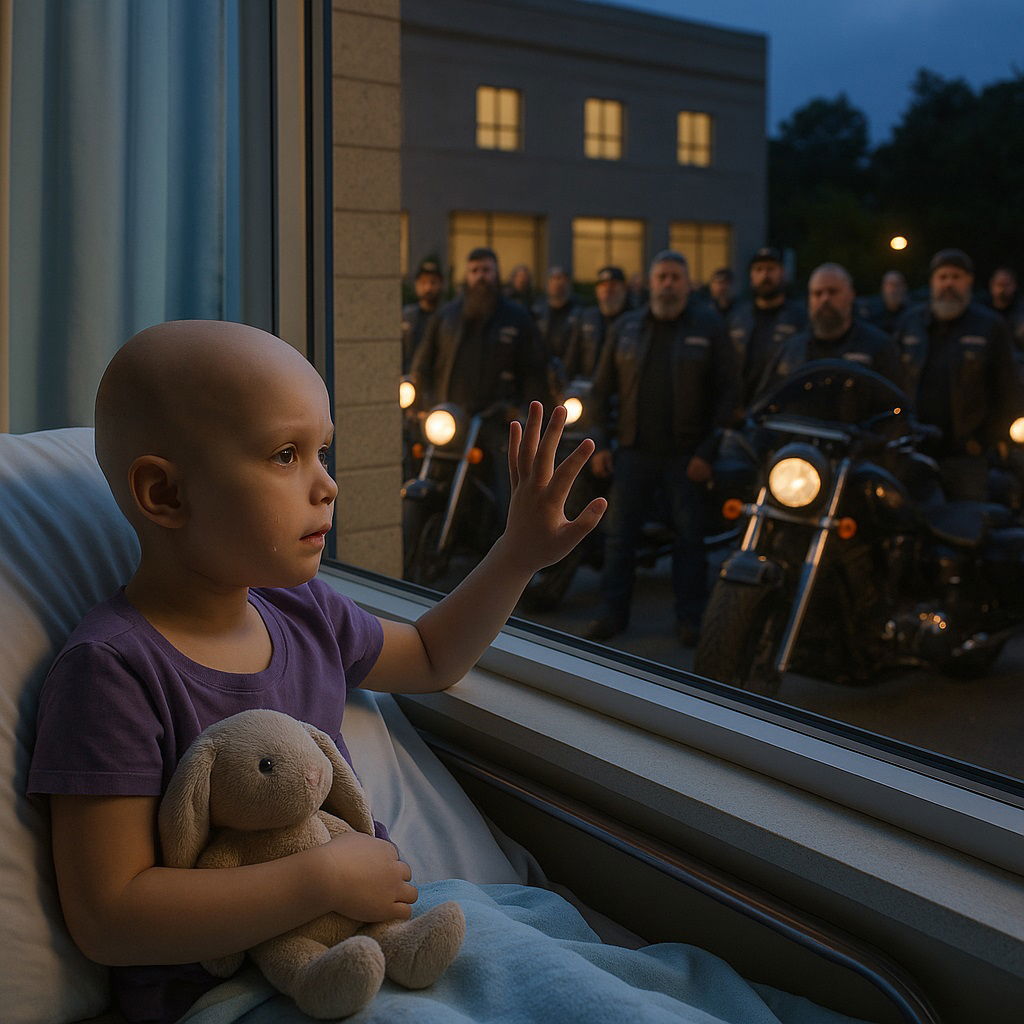
Just outside her window, parked in a perfect semi-circle, were 63 motorcycles and their riders. Men and women in leather vests, their faces weathered by wind and sun, stood with heads bowed or eyes lifted to her window. But it wasn’t just the bikes or the people — it was what they wore.
Sewn onto every single vest was a patch: a butterfly with flame-colored wings and a strong, determined expression. Beneath it, in bold embroidery: Emma’s Warriors.
This wasn’t a publicity stunt. These weren’t strangers. These were the Iron Hearts Motorcycle Club — a group of bikers who had become our family in the fight against cancer. Who’d stood with us through every bleak diagnosis, every hospital stay, every night I cried in silence beside Emma’s bed.
They weren’t just there to ride.
They were there because they loved her.
It began nine months earlier on a spring morning that shattered my world.
Emma had always been a light — bright, curious, full of energy. One day she was chasing butterflies in the yard, and the next, she was lying on the floor, pale and breathless.
The diagnosis came swiftly: acute lymphoblastic leukemia.
The words barely registered as I sat in Dr. Morrison’s office, gripping the armrests like they were keeping me anchored to the earth. The best treatment was experimental. Hopeful. But outrageously expensive: $200,000. Insurance wouldn’t touch it.
I remember stumbling to my car, numb, and locking the doors. I sat there outside Murphy’s Diner and sobbed. I couldn’t move, couldn’t breathe. My daughter’s life had a price tag, and I didn’t have the funds to buy time.
That’s when I heard it — a low rumble, followed by the unmistakable arrival of motorcycles.
A dozen bikers rolled into the diner parking lot for their weekly gathering. I tried to hide my face, but one of them spotted me.
He was enormous — built like a brick wall, tattooed arms, thick beard, a vest covered in patches. His name, stitched in red thread, read: Big Mike.
He approached my car and gently knocked on the window.
“Ma’am, are you alright?” he asked. His voice was low, steady, and kind.
I cracked the window and whispered the truth — all of it. Emma’s diagnosis. The cost. The hopelessness eating me alive.
He listened silently.
When I finished, he didn’t ask questions. He just nodded.
“No one fights alone,” he said, tapping his vest.
The next morning, the hospital parking attendant waved me through. I stared in confusion.
“Already paid,” he said. “Some biker group covered your pass for the month.”
And just like that, they were with us.
One by one, the Iron Hearts showed up for appointments, sat with me during chemo sessions, brought Emma gifts — butterfly stickers, purple scarves, toy motorcycles, even a monarch plushie she clung to every night.
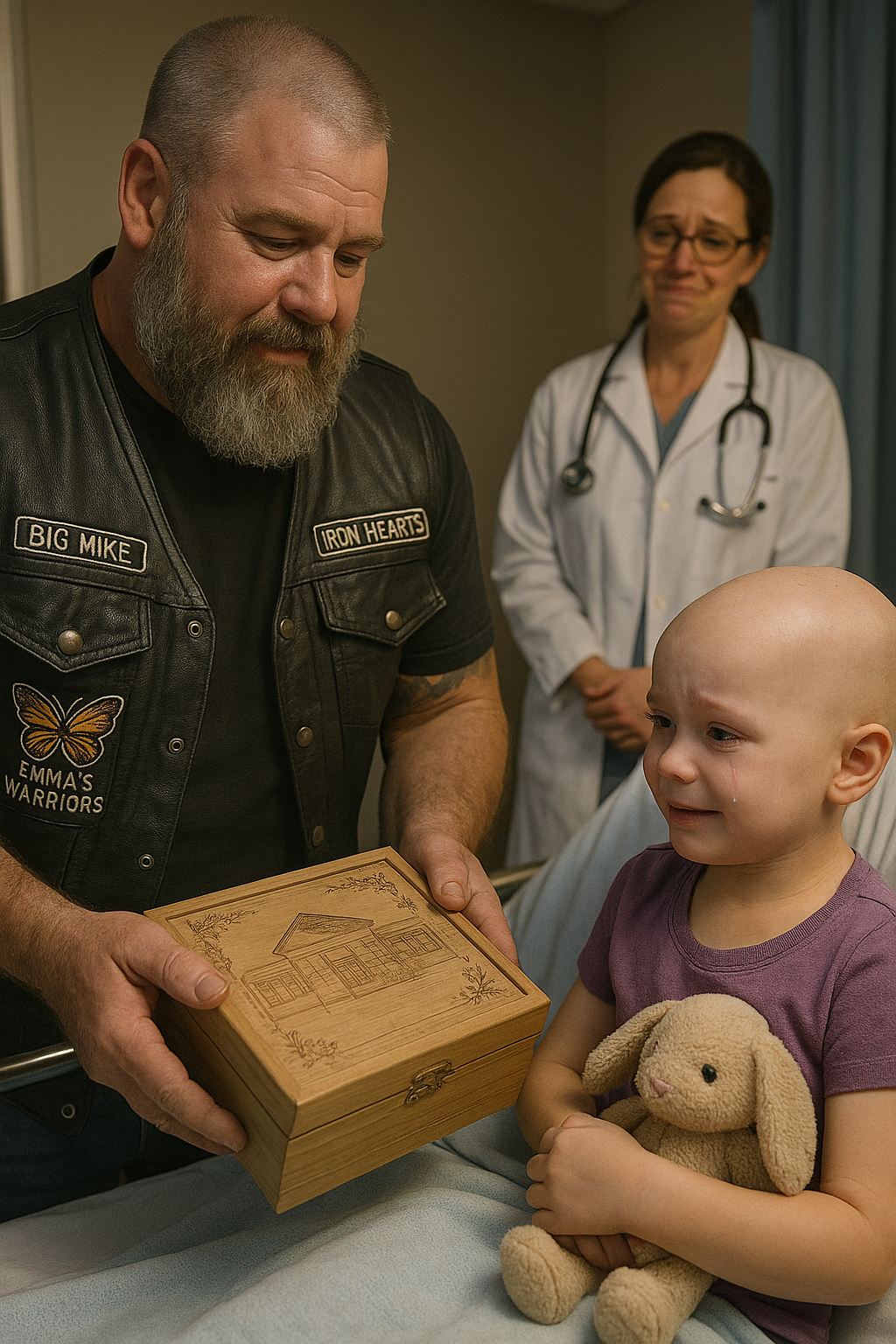
At first, the nurses were skeptical. But then came the day when Tiny Tom — their shortest member with a giant heart — held a newborn patient for three hours straight, cradling him in his inked arms and singing lullabies in a voice cracked by years but warm with soul.
From that day on, the staff welcomed them like family.
Emma especially adored Big Mike. She once whispered to him during a long chemo session, “I wish I had a vest like yours.”
Mike smiled. “What would it look like?”
She thought hard, then grinned. “A butterfly. But tough. A butterfly that fights back.”
Two weeks later, Mike returned with a tiny leather vest. On the back: a fierce butterfly with flaming wings and the words Emma’s Warrior.
She wore it over her hospital gown with pride. Bald head, IV lines, and all — she looked like the tiniest rebel angel. She strutted through the halls like she owned them.
But the Iron Hearts didn’t stop with Emma. They started fundraising — hosting poker rides, cook-offs, auctions. They created the Iron Hearts Children’s Fund.
Their mission? To help families like mine.
Emma’s butterfly became their symbol — stitched onto every rider’s vest, painted onto bikes, even worn as pendants.
One day, I was in the hospital lobby, overwhelmed again. Emma’s condition had worsened, and the next treatment cost another $200,000. I hadn’t said a word to anyone. They’d already given us too much.
But somehow, Mike knew.
He walked up to me and said, “Family meeting. Clubhouse. Seven o’clock.”
I’d never been to the Iron Hearts’ clubhouse. I expected grit, smoke, maybe a jukebox. But what I found was warmth.
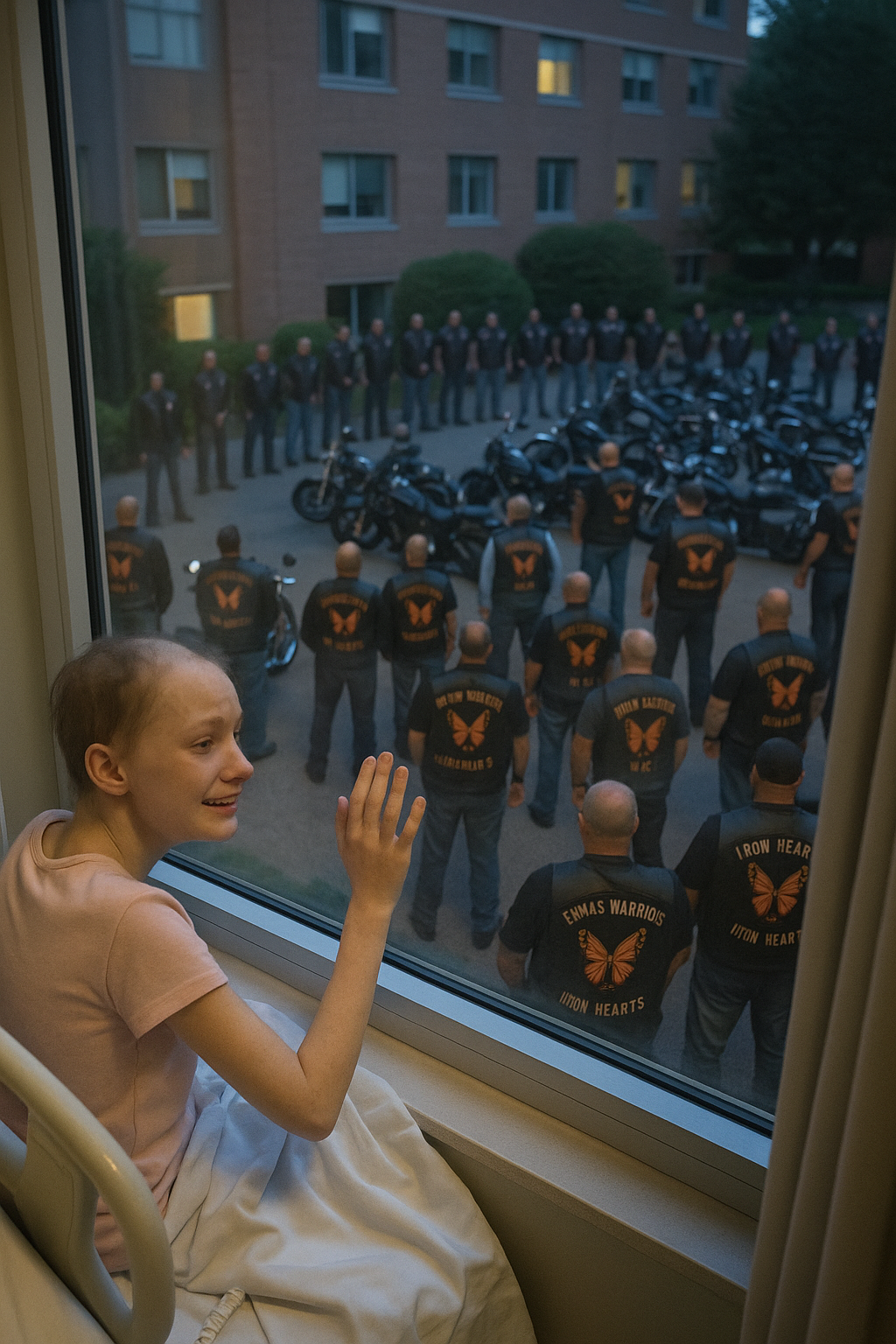
Photos lined the walls. Laughter echoed. Sixty-three bikers sat waiting.
On the table: a wooden box.
Mike handed it to me. “Open it.”
Inside was a flood of hope — envelopes, checks, cash. Records of bake sales and charity events.
At the very bottom: a slip reading $237,000.
“For Emma,” Mike said, voice breaking. “And for every kid like her.”
I couldn’t speak. Grown men wiped away tears as quietly as they could.
Unbeknownst to me, one of the riders — a documentary filmmaker — had been capturing everything: the hospital visits, the fundraisers, Emma’s journey.
That film made it to Rexon Pharmaceuticals — the very company behind Emma’s treatment.
The next day, I got a call.
“We saw Emma’s story,” they said. “We’re covering her treatment. And we’re launching the Emma Fund to help children across the country.”
I dropped the phone and wept.
And that’s what led to the moment at 7 PM outside Emma’s window.
The roar of sixty-three bikes. The flash of butterfly patches. The silence that followed, filled only by the sound of my daughter breathing — smiling — watching.
But it wasn’t over yet.
Big Mike stepped forward and opened another wooden box. Inside: a set of architectural plans. A plaque. A new address.
They hadn’t just raised money. They had bought a building.
A home-away-from-home for families of children undergoing cancer treatment. A sanctuary.
It would be called Emma’s Butterfly House. Her butterfly would be painted on the front door. She would be its heart.
Three Years Later
Emma is eleven now. In remission. She’s grown into her vest — it’s two sizes bigger, but still carries that butterfly across the back.
Every charity run, she rides behind Big Mike, arms wrapped tight around his leather jacket, wind in her face, laughter in her throat.
The Butterfly House has now helped over 200 families.
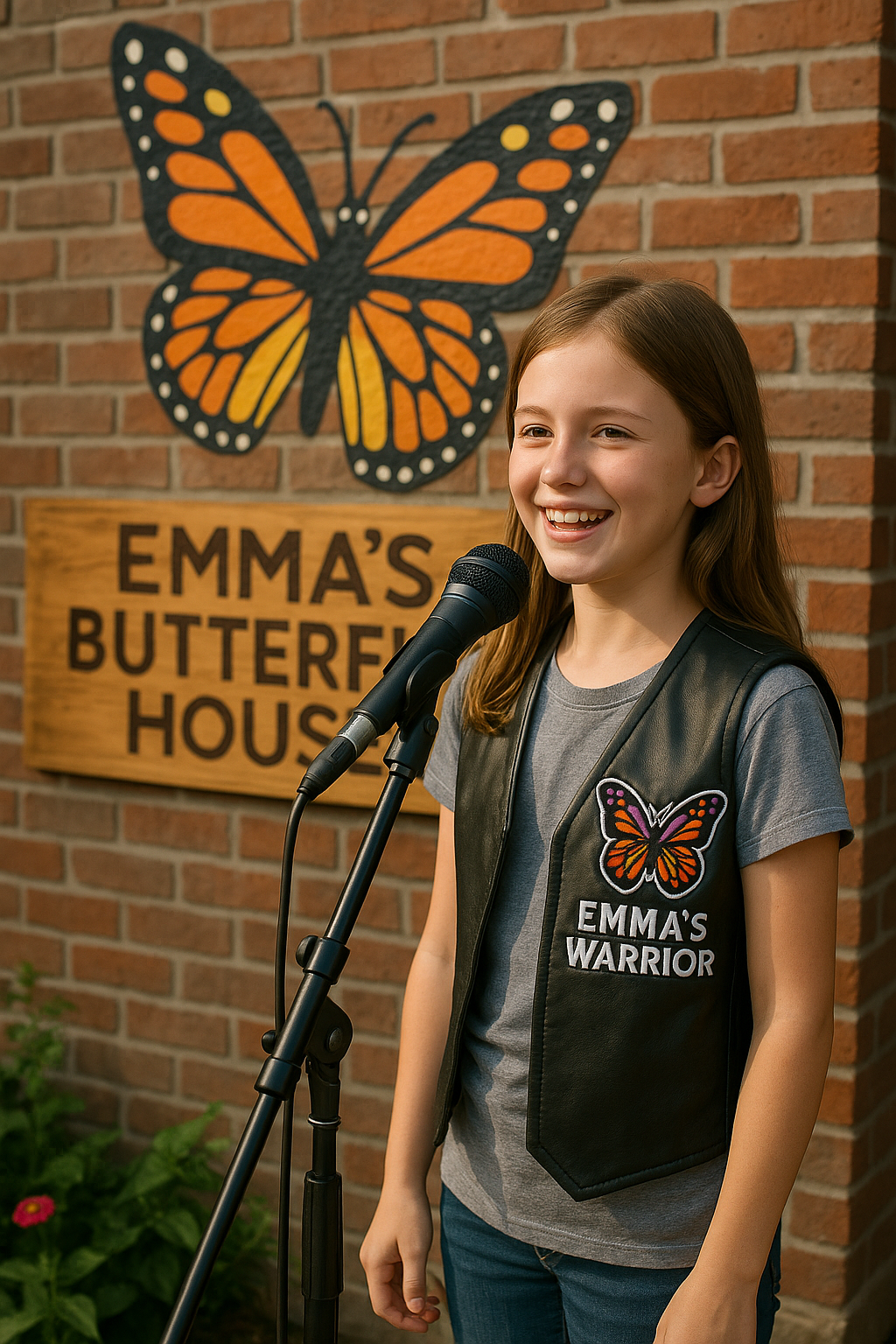
Emma’s drawing is everywhere — on walls, brochures, stickers, t-shirts. It’s more than a symbol. It’s a promise.
At every fundraiser, Emma takes the mic and tells her story. She always ends with the same line:
“People think bikers are scary. But I see angels in leather. I see my warriors. I see my family.”
And every time — without fail — sixty-three hardened men, many of whom have never cried in public, break down like children.
Because real warriors don’t fight with fists.
They fight with heart.
They fight with loyalty.
They fight with love.
